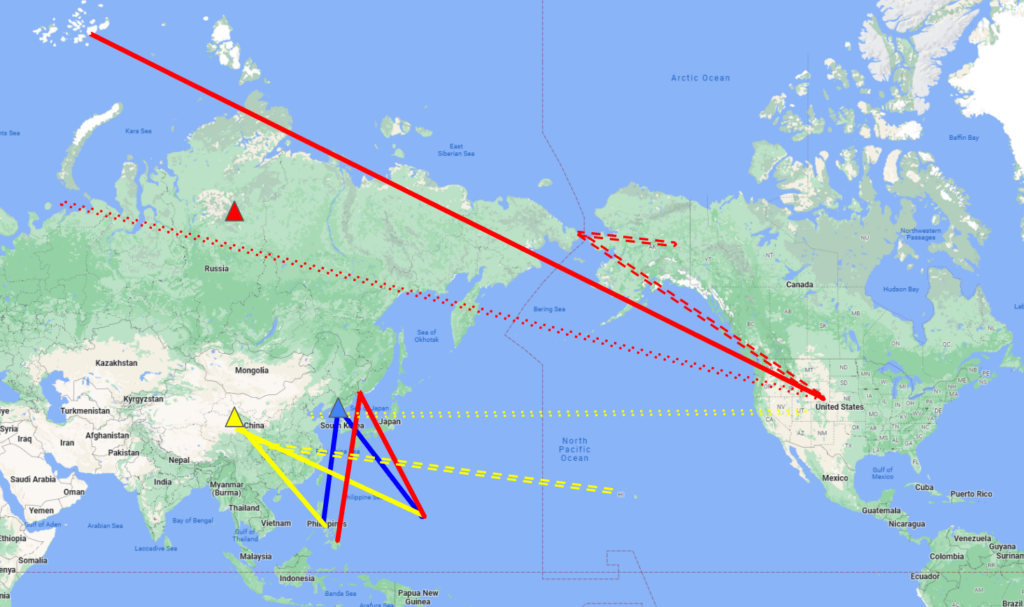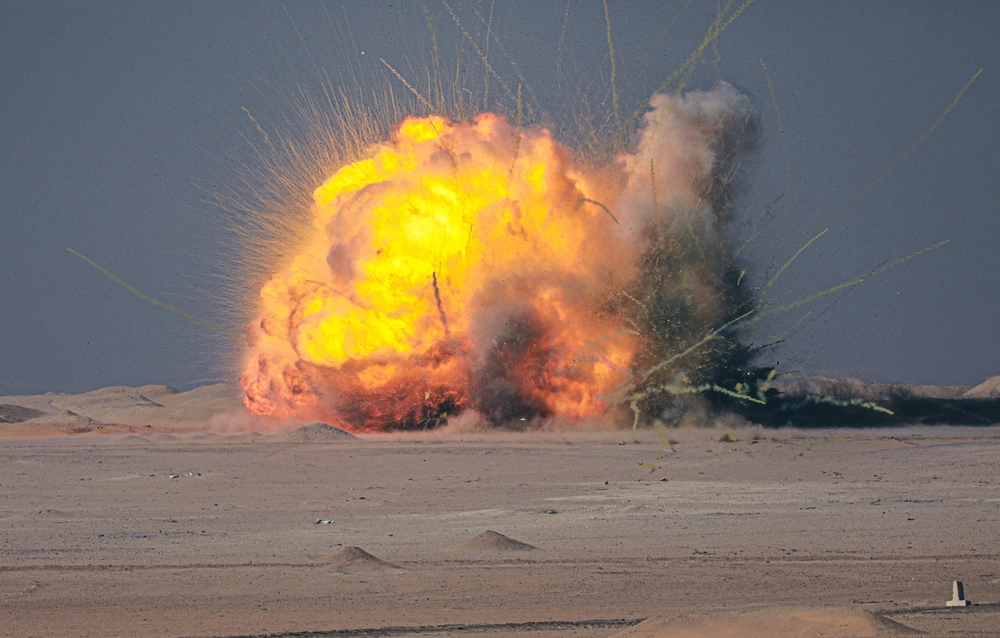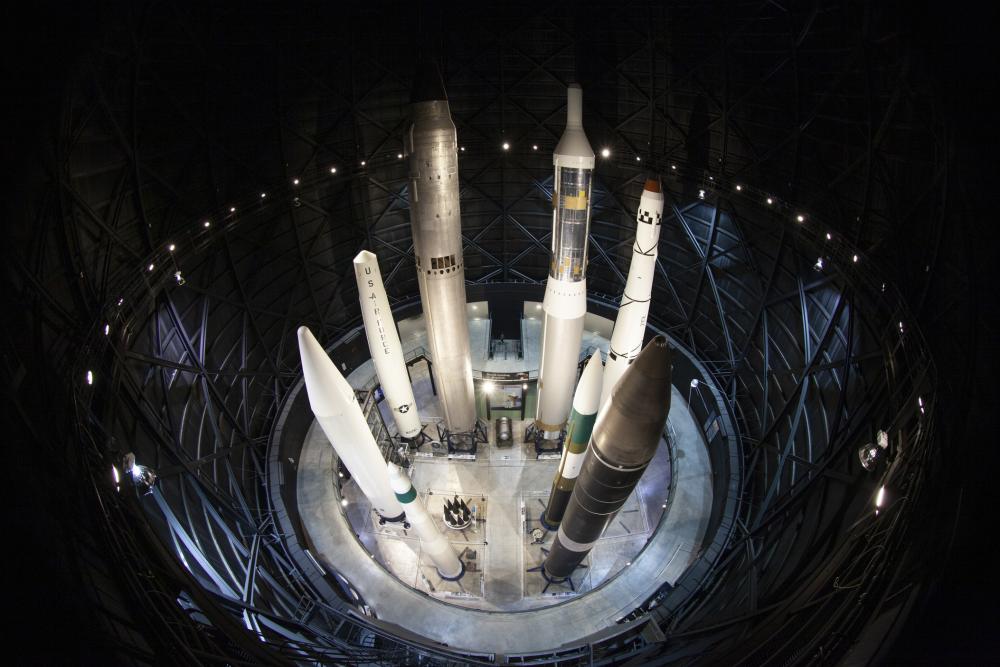The Threat
Since the invasion of Ukraine by Russia, the constant incursions into Taiwan’s ADIZ by China, and the unprecedented test launch of missiles by North Korea all in 2022, many believe that there could be a larger war in the future involving these countries. Multiple high ranking military officials in the US, as well as recent DOD and CIA threat reports, speculate that China could move to invade Taiwan as early as 2025. Promise of support to Taiwan given by the US and defensive pacts with allies in the region, the US could be brought into the fold of a war in East Asia in the future. Russia, China, and North Korea create the Triumvirate of Threat in Asia to the US, and all possess the standoff capability to strike any US territory with nuclear ICBMs. However, they also possess other missiles that possess threats to US territory and interests that we do not have precise capabilities to defend against at this time. While we can defend against standard ICBMs, we do not have defense systems dedicated to hypersonic glide vehicle (HGV) warheads that can outmaneuver current missile defense systems. This page is dedicated to outlining the threat capabilities of each of the Threat Triumvirate members in terms of missiles and their nuclear arsenal. It describes their SSBN, long range bomber, and HGV missile capabilities and their relation to US territory in the Pacific region. At the end, it specifies the threat of each country to the US and the key armaments that make stand out as high threats. This page stands as a critical analysis of the nuclear threat that these three countries pose to the US and its interests as of 2023.
Overview Threat Capabilities
Russia
- Avangard HGV VLS up to 6,000km range. Able to hit upper most US states and Alaska from the Franz Joseph Land Archipelago.
- Sarmat-28 up to 18,000km range. Able to hit any US territory from anywhere in Russia.
- Kinzhal HGV air launched up to 2,000km range. Russian fighter plane with range of 3,600km makes for a combined range of up to 5,600km, able to hit Guam from around Vladivostok. Able to hit Alaska and the West coast from bases around the Sea of Okhotsk and Bering Sea.
- Severodvinsk, lead Yasen-class submarine. Up to 40 Kalibr missiles, 2,000-4,000km range, Russia has at least 8 Yasen-class submarines.
- Borei-class submarine. Bulava ballistic missile, up to 9,500km range, 16 missiles in each submarine. Can hit any US territory from Anadyrskiy Gulf to Pechora Sea, can hit all US territories except Hawaii from the port of St. Petersburg.
- Tu-95 bomber range up to 7,000km, Can be launched from anywhere in Russia with Kalibr missile.
- Standoff range from far eastern territory of Russia 1,200km from Fort Greely, and Anchorage. 3,500km from Seattle, 5,000km from LA, 3,500km from Guam, 3,000-4,100km from Philippines
- Burevestnik nuclear powered, nuclear capable cruise missile, unlimited range, operational by 2025.
China
- JL-3 SLBM: Up to 12,000km range. It would be able to hit Washington D.C. from the safety of the Yellow Sea or port of Tianjin near Beijing.
- The new Type 096 submarine will be the quietest submarine in the Chinese navy. The Chinese will have JL-3 missiles fully integrated into Type 096 submarines by 2025, and the US DOD estimates them to construct at least 8 Type 096 by 2030.
- China is one of the only countries to possess successfully tested hypersonic glide vehicles that can be placed as nuclear warheads on DF-17 IRBMs.
- China’s DF-41 is their longest range ICBM with up to 15,000km range. This missile would be able to hit any location in the US territories from the location of Yumen and Hami, where 200 new ICBM missile silos were built.
- All of China’s missiles (ballistic, cruise, hypersonic) would be able to hit Taiwan’s capital from mainland China (170-200km distance). ICBMs and SLBMs would be able to hit Guam from the closest Chinese constructed island (3,300-3,500km distance). Everything from MRBM and up would be able to hit anywhere in the Philippines from closest Chinese islands (1,300-1,400km distance) (Spratly island chain).
- J-20 stealth fighter (up to 3,200km range) fires PL-15 AAM (300km).
- H-6 bomber (6,000km range) and future H-20 (up to 8,000km) could air launch Starry Sky-2 HGV cruise missiles (700-800km).
- More ICBM launchers than US.
North Korea
- All ICBMs able to hit any US territory (10,000-15,000km range).
- Hwasong-8 HGV (up to 3,200km range) is able to reach Guam.
- Two Ballistic Missile Submarines, launches KN-23 SRBM (up to 700km range). 40 coastal submarines.
- Long range nuclear capable cruise missile.
Threat Assessment

Dashed line: Bomber with AGM
Dotted line: Submarine with SLBM
Triangle: Capability to hit any US territory with standard ICBMs
Red: Russia
Yellow: China
Blue: North Korea
Russia
- Homeland defense threat/Pacific regional threat
- Key threats
- Avangard HGV – Homeland (Upper half of the US, Alaska)
- Kinzhal HGV – Regional (Guam, Philippines)
- Tu-95 LRSB – Homeland (Continental US)
- Bulava SLBM – Homeland/Regional (Can hit anywhere in US from port of St. Petersburg, Philippines and Guam)
- Burevestinik – Homeland/Regional (All territories)
China
- Homeland defense threat/Pacific regional threat
- Key threats
- DF-17 HGV – Regional (Guam, Philippines)
- JL-3 SLBM – Homeland (All US territories)
- H-6/20 LRSB -Regional (Hawaii, Pacific territories)
North Korea
- Pacific regional threat
- Key threats
- Hwasong-8 HGV (Guam,Philippines)
Russia is the most versatile threat to US territories with the ability to use Air, Land, and Sea capabilities to attack US territories in the homeland and Pacific area. They have the Avangard hypersonic glide vehicle (HGV) ballistic missile that can reach the northern half of the US from their Franz Joseph Land archipelago near the Arctic. Their Kinzhal HGV cruise missile is capable of hitting Alaska, the West coast of the US, Guam, and the Philippines from Vladivostok, and can be launched from the ground or by plane. The US does not have reliable defenses against these HGV missiles, however the SM-6 interceptor has shown promise in test simulations against HGVs. Russia’s Tu-95 long range strategic bomber (LRSB) can reach the Pacific territories, Alaska, and the mainland US using Kalibr cruise missiles, still within their territorial borders from the Sea of Okhotsk, and Bering Sea. Russia’s Borei-class submarines that can launch Bulava ballistic missiles for a range of 9,500km, can hit any US territory from the Anadyrskiy Gulf to Pechora Sea and can hit any point in the US homeland except for Hawaii from the port of St. Petersburg. Russia also has the capability to hit any US territory from anywhere in their country using ICBMs. Russia is planning to develop their nuclear powered, nuclear capable Burevestnik cruise missile which would have an unlimited range by 2025.
China is the biggest threat to the US’ Pacific regional interests, and is the most rapidly developing threat to the US. China’s DF-17 HGV ballistic missile and Starry Sky-2 HGV cruise missile can target Guam, the Philippines, and Taiwan from China’s coastal regions with no adequate defenses against them. Their H-6 LRSB and H-20 LRSB that will be coming out soon can target those regional Pacific territories, as well as reaching Hawaii using the conventional cruise missiles and the Starry Sky-2 HGV cruise missile. Using the Type 094 and Type 096 submarine with the JL-3 SLBM with a range of 12,000km, China can reach any US territory from the Yellow Sea and port of Tianjin (Closest port to Beijing). China is expected to have JL-3 SLBMs fully integrated into Type 096 SSBNs by 2025. China has at least 400 operational nuclear warheads with at least 320 ICBM inground silos, with 300 of them having been built since 2021. China is speculated to have an estimated 1,500 nuclear warheads by 2035. They also have the infrastructure and logistics to operate 320 ICBMs. China has the nuclear standoff range to target the US homeland, while also having a varied arsenal to target regional territories of interest in the Pacific.
North Korea is the smallest individual threat to the US and territories, but is a substantial partnered threat to the US. Their Hwasong-8 HGV ballistic missile with a 3,200km range is able to reach Guam and the Philippines. North Korea is a regional threat to South Korea and Japan with a wide SRBM and MRBM arsenal. They have 2 ballistic missile submarines that launch the KN-23 SRBM with a 700km range. It is a partnered threat to the US by being able to work in conjunction with more technologically developed neighbors like Russia and China. North Korea’s main threat to the US is their ability to hit US Pacific territories, but the threat is substantial as it’s an HGV nuclear capable ballistic missile with no strong defenses. If partnered with China, North Korea has the capacity to severely threaten US territories in the Pacific, while also having the capability to threaten South Korea and Japan. This would allow China to focus more of its arsenal on Taiwan, and all US territories. North Korea poses a dangerous partnered threat in the Pacific region.
More on the Threat of Future War with the cost of destruction from missiles with Chemical, Biological, and Nuclear warheads:
Missile Payload Destruction Cost Comparisons

More on the Threat of Future War with analyses of new developing technology by Russia, China, and North Korea:
Technological Threat Assessment


